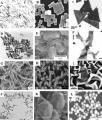
Frontiers in Chemistry
by B Viswanathan
Publisher: National Centre for Catalysis Research 2007
Number of pages: 231
Description:
On the scientific side, the introduction of new techniques which can virtually see at molecular level has revolutionized the way chemistry is practiced today. One has
started looking at nano scale and started designing and fabricating tools at nano scale. This can have far reaching consequences and the expected surprises can be in almost all
sectors of human endeavour. It is therefore natural that the teaching and learning of Chemistry have also to change.
This is evident from the methodology that one has to adopt since lecture based courses are not longer appealing and one has to use a variety of soft ware tools to demonstrate
and make the molecules perform so that the teacher and the taught is enjoying the knowledge transfer process in a totally different platform.
Download or read it online for free here:
Download link
(multiple formats)
Similar books
 Chemical Principles
Chemical Principlesby R.E. Dickerson, H.B. Gray, G.P. Haight - Benjamin/Cummings
A general university chemistry textbook, it provides an overview of chemistry for nonspecialists and a foundation for later study for chemistry majors. The text introduces different areas of chemistry: inorganic, nuclear, organic, and biochemistry.
(29735 views)
 Introduction to General Chemistry
Introduction to General Chemistryby H.N. McCoy, E.M. Terry - McGraw-Hill
The book has been written for college Freshmen, and, as its title implies, it is intended to serve as an introduction to general chemistry. In consequence we have aimed to present a continuous and connected story in teachable form.
(11066 views)
 A Concise History of Chemistry
A Concise History of Chemistryby Thomas Percy Hilditch - D. Van Nostrand
This book is an attempt to outline as briefly and succinctly as possible the historical development of chemistry. It is presumed that the reader is acquiring, or already possesses, a fair knowledge of present-day chemical theory and practice.
(12815 views)
 Chemical Ecology: The Chemistry of Biotic Interaction
Chemical Ecology: The Chemistry of Biotic Interactionby Thomas Eisner, Jerrold Meinwald - National Academies Press
This book highlights selected research areas that are contributing to advancement of chemical ecology. Leading experts review the chemistry of insect defense; phyletic dmoninance; social regulation; eavesdropping, alarm and deceit; and reproduction.
(20291 views)